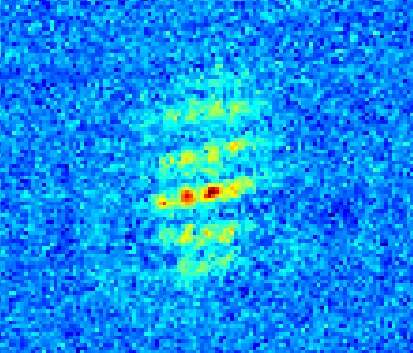Absorption image of the atom cloud at an exit port of the interferometer. Two stripe-shaped modulations are visible, which leads to a checked pattern in the density distribution. The former structure is the result of inferences of the partial waves while the latter is achieved through phase imprinting. Credit: Lachmann/IQO
In 2017, a team of researchers led by Leibniz University Hannover succeeded in generating Bose-Einstein condensates in space within the scope of the MAIUS-1 rocket mission. Bose-Einstein condensates describe a highly unusual state of matter close to absolute zero and can be illustrated with a single wave function. Through time-consuming analyses, the researchers studied different components of the condensate. Their findings have now been published in the scientific journal Nature Communications. This marks the beginning of extremely accurate measurements via atom interferometry in space.
According to Dr. Maike Lachmann from the Institute of Quantum Optics—one of the authors of the study—possible applications include precise tests in the field of fundamental physics, such as the universality of the free fall. Moreover, their findings could be used for high-precision navigation, Earth observation via measurements of the Earth's gravitational field, as well as in the context of the search for dark energy or the detection of gravitational waves.
Bose-Einstein condensates in space are currently considered the most promising source of atom interferometry. For this purpose, a matter wave is released in free fall and analyzed by means of an interferometer. The precision of the measurement increases with the duration of the free fall in the interferometer. On Earth, short-term microgravity can be achieved in special drop towers or very long vacuum chambers. However, significantly longer drop periods and therefore more accurate measurements can be reached in space.
In the MAIUS mission, the researchers used a cloud of rubidium atoms in order to generate a Bose-Einstein condensate, which was cooled down to close to absolute zero through the interaction of light and magnetic fields. All particles of this cloud can then be described with a single wave function. By means of atom interferometry with a special geometry, the team proved the coherence of the ensemble and therefore the capacity for interference. For this, they initially divided the wave packet spatially and recombined it afterwards. A small spatial displacement of the wave packets during the recombination results in interferences visible in the density distribution of the ensemble in the form of horizontal stripes, which verifies the coherence of the ensemble on time scales of a few milliseconds. This method is used to conduct highly precise measurements of inertial forces with unmatched accuracy.
By changing the intensity of the involved light fields, the researchers succeeded in changing the density distribution of the matter wave, therefore achieving a phase imprint visible as a vertical stripe pattern. This method can be used to analyze environmental conditions, in this case a magnetic field curvature in the background.
More information: Maike D. Lachmann et al. Ultracold atom interferometry in space, Nature Communications (2021). DOI: 10.1038/s41467-021-21628-z
Journal information: Nature Communications
Provided by Leibniz Universität Hannover























